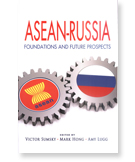
Russia Looks South As Well As East
*Author, Mihoko Kato is Senior Associate Member of St. Antony’s College, Oxford University, and GCOE Research Fellow at the Slavic Research Center, Hokkaido University, Japan.
ASEAN-Russia: Foundations and Future Prospects
Edited by Victor Sumsky, Mark Hong and Amy Lugg
Singapore: ISEAS Publications, 2012, 376 pages, S$59.90/US$52.90 (Softcover)
SINCE VLADIVOSTOK WAS CHOSEN as the venue of the APEC Summit 2012 at the initiative of Vladimir Putin in January 2007, scholars and analysts have actively discussed the process of Russia’s political and economic integration into the Asia-Pacific region. Previous studies have tended to focus on the bilateral relations and mutual perceptions among the six major powers in Northeast Asia (China, Japan, Russia, South Korea, North Korea and the US) — in particular, the characteristics and the potential of the Russo-Chinese strategic partnership. However, Moscow has actually striven to diversify its relations and the fields of international co-operation not only with Northeast Asian partners, but also Southeast Asian countries since the mid-1990s.
This newly published book, ASEAN-Russia: Foundations and Future Prospects, reveals how Russia and the member countries of the Association of Southeast Asian Nations (ASEAN) have developed a political and legal basis for Russia-ASEAN co-operation from a low level since 1996. It explores what sort of challenges the two sides face today to facilitate Russia’s further engagement with the economic integration and security architecture of the Asia-Pacific region from the viewpoint of practitioners and academics.
This timely book is the third in a series of books on ASEAN-Russia relations and is the result of the third ASEAN-Russia Conference, organized in April 2011 by the Institute of Southeast Asian Studies (ISEAS) and the Moscow State Institute of International Relations (MGIMO University).
The first section of this book provides a range of expert views on Russia’s prospective role and the future of Russia-ASEAN relations in the context of relations with rising powers such as China and India and the historical rivalry with Japan. Most authors in this section seem to be in agreement with the significance of Russia as an energy supplier in place of the Middle East and the need for energy partnerships between Russia and Asia-Pacific countries. They also discuss the security aspects of community-building that include all other countries in the Asia-Pacific and Russia. As Rajiv Sikri argues, it would be unrealistic to expect rapid progress in this sphere under existing conditions, where there are few shared views on what constitutes a regional identity among Asia-Pacific countries.
What distinguishes this volume from the previous two is the extent to which some authors argue in more depth for the need to expand and utilize Russia’s potential “soft power” in Asia, and also the need for Russia to develop strategic and friendly relations with China, the two Koreas and, in particular, Japan.
Sections 2 through 5 of the volume deal with geopolitics, bilateral relations, business and economics, and culture and education. One point made throughout is that Russia in recent years has become a much more visible player in Asia due to its membership in the East Asia Summit (EAS), its participation in the Asia-Europe Meeting (ASEM) and its upcoming role as host of the APEC Summit in September.
Section 2 looks at Russia’s changing role in Asia from an historical perspective and in the context of recent changes in the global order, suggesting ways in which Russian policy toward ASEAN is evolving in the context of competition between the US and China. The section also sheds light on the rationale behind Russia’s participation in EAS and ASEM, a subject that hasn’t received much attention from scholars. Section 3 looks specifically at Russia’s bilateral relations with Singapore, Burma, Thailand, Vietnam, Malaysia and Cambodia.
The fourth section of the volume contains only 71 pages but is one of the highlights of this book, in my view. It examines the current relations and economic potential that exist between Russia and its former allies in Indochina — Vietnam, Laos, Cambodia and Myanmar (Burma). While these “ASEAN 4” countries have achieved high economic growth rates as a result of investments from other ASEAN members, as well as China, Japan, South Korea and the US, the authors argue that Russia, too, is poised to reap opportunities in these ASEAN countries in the area of arms trade, high technology, education, tourism and energy — including nuclear energy.
The fifth section of the volume focuses on the potential for Russia’s exercise of soft power in ASEAN, a subject that has gained increasing attention from both sides in recent years.
Although the focus of the book is Russian-ASEAN relations, most of the contributors broaden their focus to include Russia’s relations with the entire region. In this respect, this is a must-read book for anyone studying Russian foreign policy in Asia. <Global Asia/Mihoko Kato>



